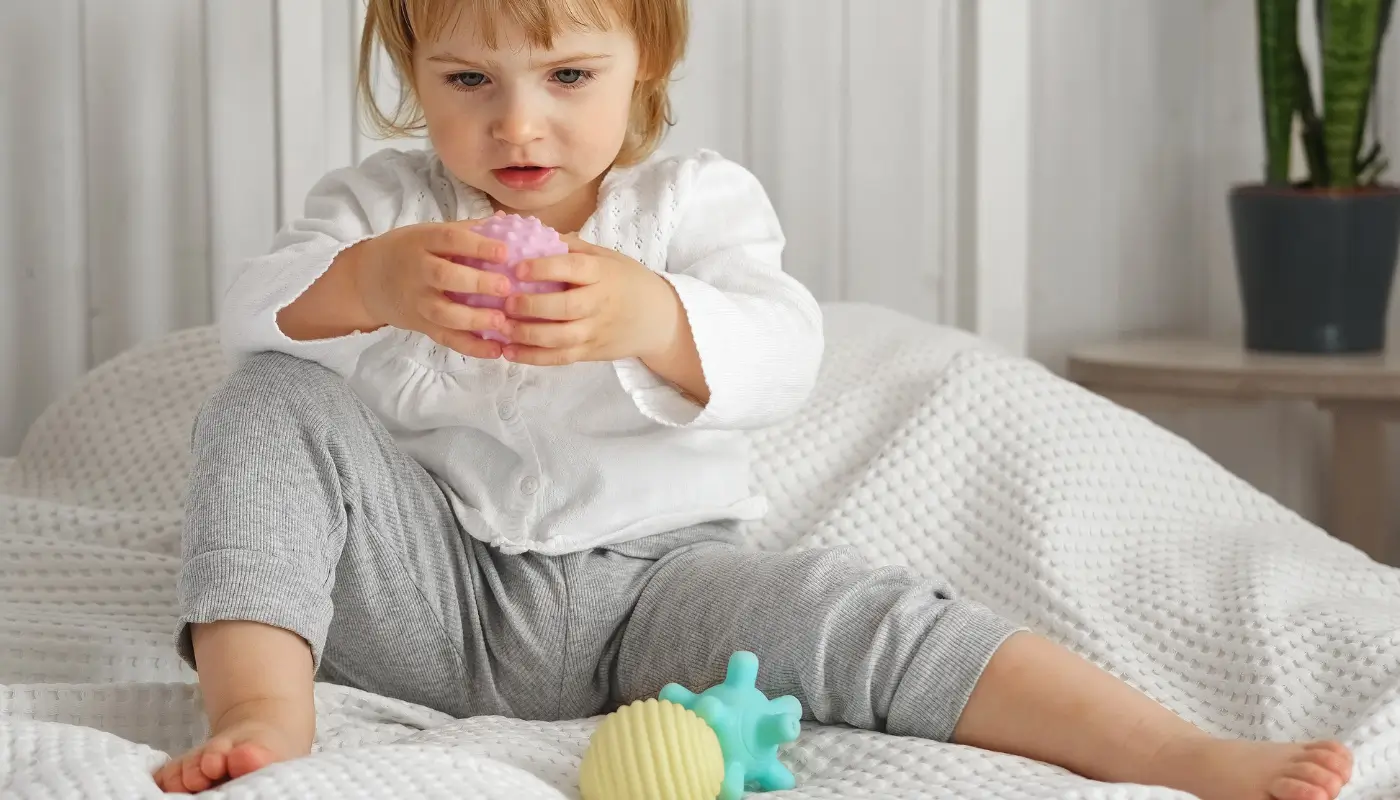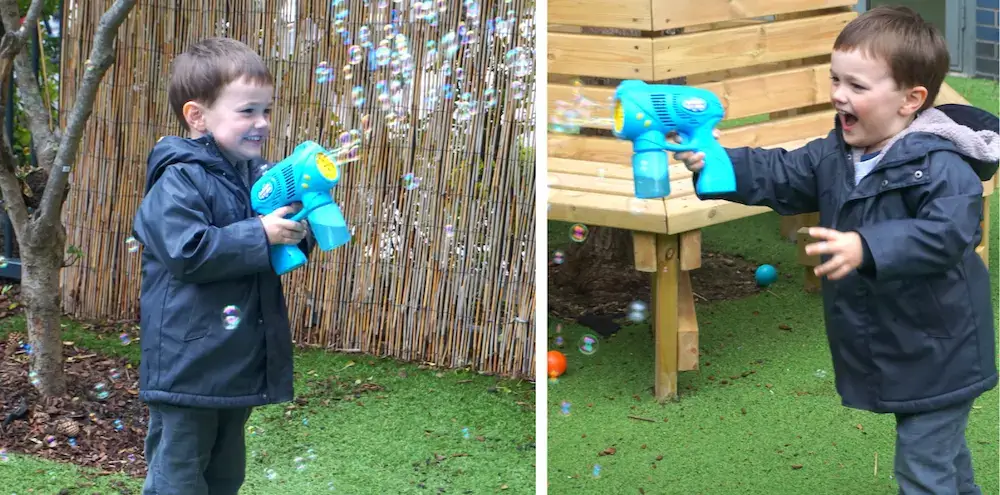In recent years, there has been a growing awareness and understanding of Autism Spectrum Disorder (ASD). This developmental condition impacts children in lots of different ways, from their communication skills to their interests, and parents of children with autism often face unique challenges too. One of these challenges is finding appropriate toys that are not only fun but also beneficial for their child’s growth and development.
When it comes to purchasing toys for children with autism, the goal is to find items that cater to their unique sensory needs, all while supporting key skill sets. To give you some inspiration, we have created a list of 8 toys our therapists and registered behaviour technicians are using when delivering Applied Behaviour Analysis (ABA) therapy.

SEnsory Balls
Sensory balls are versatile play items that are designed with various tactile experiences in mind. They come in a range of sizes, colours and textures, from smooth and squishy to spiky and bumpy. This range can engage the senses of children with autism, and they are particularly beneficial for anyone who is hypersensitive or hyposensitive to sensory stimuli. The varied designs and textures of sensory balls can support tactile perception.
Using sensory balls not only provides children with valuable sensory experiences but also encourages them to explore and become comfortable with different textures. This can be therapeutic, helping children regulate their sensory responses and develop better-coping mechanisms. Whether used in structured EIBI therapy or free play, sensory balls can be a valuable tool in establishing motivation for learning new skills as well as generalising previously acquired skills such as colour matching, colour sorting or identifying and labelling adjectives.
Activity Cubes
Activity cubes are multi-functional toys that provide children with a variety of activities in a single toy, including spinning gears, sliders, puzzle pieces and sometimes even musical elements. These diverse toys provide a multi-sensory experience, offering tactile, visual, and auditory stimulation. They can be used during solo play or cooperative play and keep children engaged for extended periods of time.
Playing with activity cubes can support motor skills development as well as instil an understanding of cause and effect. The design of these toys encourages both fine and gross motor skills, which is vital for children with unique developmental needs like those with autism. Not to mention, the variety of activities ensures that a single cube can adapt to a child’s evolving preferences and abilities, making it a long-lasting investment in their developmental journey.
Moving Lamps
Moving lamps, such as lava lamps or aquarium lamps, are unique lighting fixtures that move in a repetitive, predictable pattern. They are available in various shapes, sizes and colour combinations, offering a captivating visual experience. The lamps are particularly beneficial for autistic children due to their ability to engage attention in a calming manner.
Furthermore, these moving lamps create extraordinary opportunities for language usage and teaching more complex vocabulary such as using adjectives, prepositions or even pronouns.
Rainmakers
Rainmakers, also known as rain tubes, are transparent cylinders filled with small beads or pellets. When flipped, these beads travel down the tube, emulating both the visual and auditory sensations of falling rain. This dual sensory experience offers several benefits, particularly for children with autism. By mimicking the calming sound of raindrops, the cascading beads can soothe children. Simultaneously, watching the beads can be mesmerising.
Rainmakers have been the preferred tool in teaching children with autism at the centre how to copy movements using objects as well as engaging in purposeful play using musical instruments.

Playdough Sets
Playdough comes in an array of colours and sets often include a selection of playdough pots as well as tools for cutting, shaping and moulding the dough. They provide a hands-on, tactile experience that can engage children with autism during playtime.
The benefits of playdough sets extend beyond sensory engagement. Manipulating playdough not only enhances fine motor skills but also encourages creative expression. The act of shaping, cutting and moulding the dough into different shapes or figures can stimulate a child’s imagination, making it both an educational and therapeutic tool.
Textured Books
Textured books aren’t just printed stories, they incorporate a range of materials to provide a tactile experience. Some books also feature built-in activities that can engage auditory or even olfactory senses.
In addition to enhancing the enjoyment of reading, textured books also have educational benefits. They aid in language development by associating words with sensory experiences and can improve sensory recognition skills.

Bubble Machines
Bubble machines are designed to produce a continuous stream of bubbles. They are available in a variety of shapes and sizes, usually featuring visually appealing designs to catch the eye. Often, bubble machines have different settings too, so you can decide how many bubbles they create or how frequently new bubbles appear.
Bubble machines are a fun way of integrating following instructions during play by asking the children to pop or follow the bubbles. Furthermore, bubble play can encourage social interaction, helping to develop social skills in a fun way.
Therapeutic Swings
Therapeutic swings are similar to traditional hammocks in the sense that they are suspended pieces of fabric. Made from robust, durable materials, therapeutic swings can support the weight of a child and they’re commonly installed on a swing frame to ensure they’re safe and convenient to use. There are a variety of styles to choose from, such as net swings, pod swings, platform swings and high-backed swings, catering to every unique need.
The act of swinging back and forth provides vestibular stimulation as well as helping develop balance and spatial awareness and motor skills. Swinging allows children to gain better control over their movement and coordinate their actions more effectively. So, they’re not just a fun swing, but also a valuable tool for physical and sensory development.
Early Intensive Behavioural Intervention for Autism
Choosing the right toys for an autistic child can be difficult, but when you know what to look for you can ensure you’re purchasing the best options on the market. Always remember that each child is unique and it’s crucial to consider their individual needs, likes and dislikes.
If your child is diagnosed with autism, Early Intensive Behavioural Intervention (EIBI) could be beneficial for them too. EIBI programs can improve quality of life for children with Autism Spectrum Disorder, helping them to learn new skills. At First Bridge, we provide a range of programmes to support children with autism and their families. You can learn more about EIBI therapy on our website and our team will happily answer any questions you may have.
